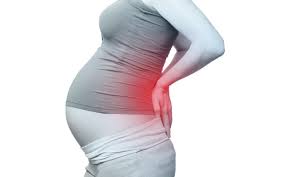
What is this condition? What causes this condition?
Pregnancy related lower back pain is common in pregnant women and can significantly impact their quality of life. The pain is noted particularly around the lumbar spine, above the sacrum and usually tenderness of the back muscles. Pain can be caused by the body preparing the patient for labour, the bodies muscles and ligaments can become softer and therefore stretch more which adds strain to lower back joints and pelvis.
The lumbar spine changes its shape to prepare for holding a baby therefore this adds excess strain on joints and muscles. The image depicts the c shape change in the lumbar spine during stages of pregnancy (Yoo et al., 2015).
Common symptoms / signs
Common symptoms include pain in the lower back region, this can be central or more lateral. Often a dull or sharp ache is felt or a burning pain. Pain may radiate into the back of the thigh and leg or foot drop may occur where the foot is unable to lift of the floor whilst walking.
Risk factors of this condition?
– History of pelvis trauma (Katonis et al., 2011)
– Chronic LBP
– Low back pain during previous pregnancy
– Higher number of previous pregnancies
– Excessive body weight
– Increase in hormones (joints and ligament soften during hormonal changes)
– Change in centre of gravity as baby weight is more forwards
How is it treated?
It is crucial for pregnant women to be educated around preventing low back pain though correct posture, ensuring their back is not misaligned or overloaded (Katonis et al., 2011). This can be prevented is exercise and activations beginning prior to pregnancy. The most common treatment is exercising, many studies suggest that water aerobics, yoga and group physical therapy can have positive effects. Specific treatment ideas include hot and cold water therapy to soothe sore muscles, posture correction, strengthening abdominal muscles through pelvic tilts, massage and ensuring correct footwear is being worn.
Other causes/differential diagnoses
Differential diagnoses include disc disease, face joint syndromes or sacroiliac joint problems. Another major cause often neglected is stress. Pregnancy can bring about mental health issues including anxiety and depression. The stress associated can be brought on particularly in weaker areas of the body. Stress increases muscle tension which can be felt as pain or muscle spasms as cortisol and adrenaline are released causing the involuntary tightening.
References
Cohen, Steven P., & Raja, Srinivasa N. (2007). Pathogenesis, Diagnosis, and Treatment of Lumbar Zygapophysial (Facet) Joint Pain. Anesthesiology, 106(3), 591-614. https://doi.org/10.1097/00000542-200703000-00024
Katonis, P., Kampouroglou, A., Aggelopoulos, A., Kakavelakis, K., Lykoudis, S., Makrigiannakis, A., & Alpantaki, K. (2011). Pregnancy-related low back pain. Hippokratia, 15(3), 205-210. https://pubmed.ncbi.nlm.nih.gov/22435016
https://www.ncbi.nlm.nih.gov/pmc/articles/PMC3306025/
Kim, B., & Yim, J. (2020). Core Stability and Hip Exercises Improve Physical Function and Activity in Patients with Non-Specific Low Back Pain: A Randomized Controlled Trial. Tohoku J Exp Med, 251(3), 193-206. https://doi.org/10.1620/tjem.251.193
Owen, P. J., Miller, C. T., Mundell, N. L., Verswijveren, S., Tagliaferri, S. D., Brisby, H., Bowe, S. J., & Belavy, D. L. (2020). Which specific modes of exercise training are most effective for treating low back pain? Network meta-analysis. Br J Sports Med, 54(21), 1279-1287. https://doi.org/10.1136/bjsports-2019-100886
Shiri, R., Falah-Hassani, K., Heliövaara, M., Solovieva, S., Amiri, S., Lallukka, T., Burdorf, A., Husgafvel-Pursiainen, K., & Viikari-Juntura, E. (2019). Risk Factors for Low Back Pain: A Population-Based Longitudinal Study. Arthritis Care Res (Hoboken), 71(2), 290-299. https://doi.org/10.1002/acr.23710
Yoo, H., Shin, D., & Song, C. (2015). Changes in the spinal curvature, degree of pain, balance ability, and gait ability according to pregnancy period in pregnant and nonpregnant women. J Phys Ther Sci, 27(1), 279-284. https://doi.org/10.1589/jpts.27.279
